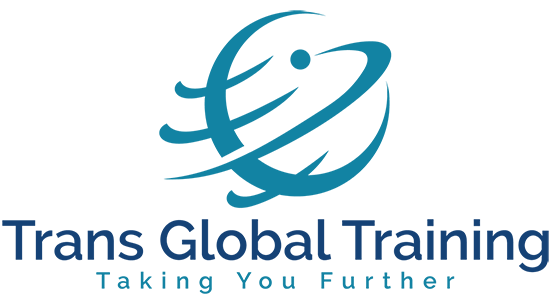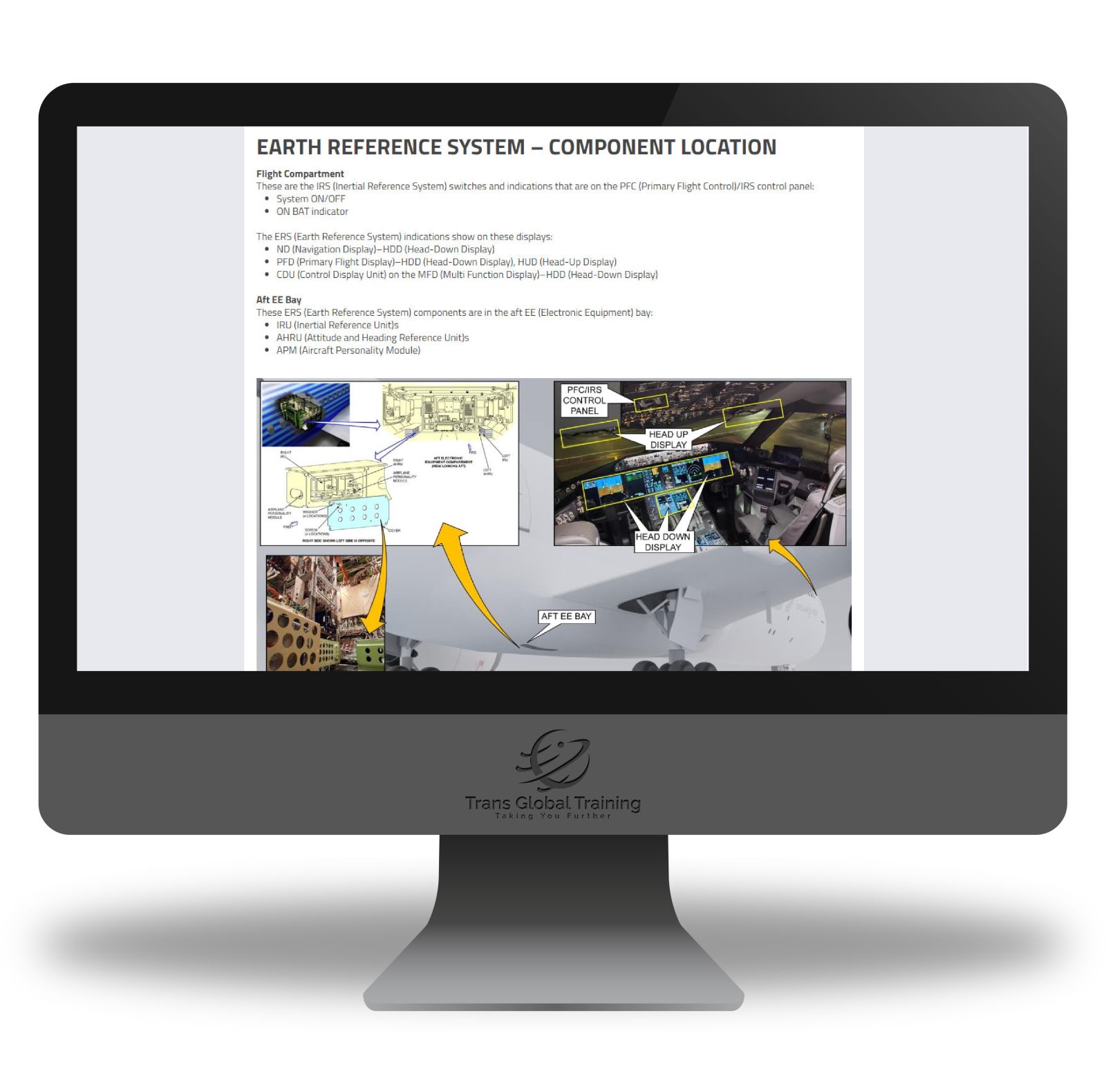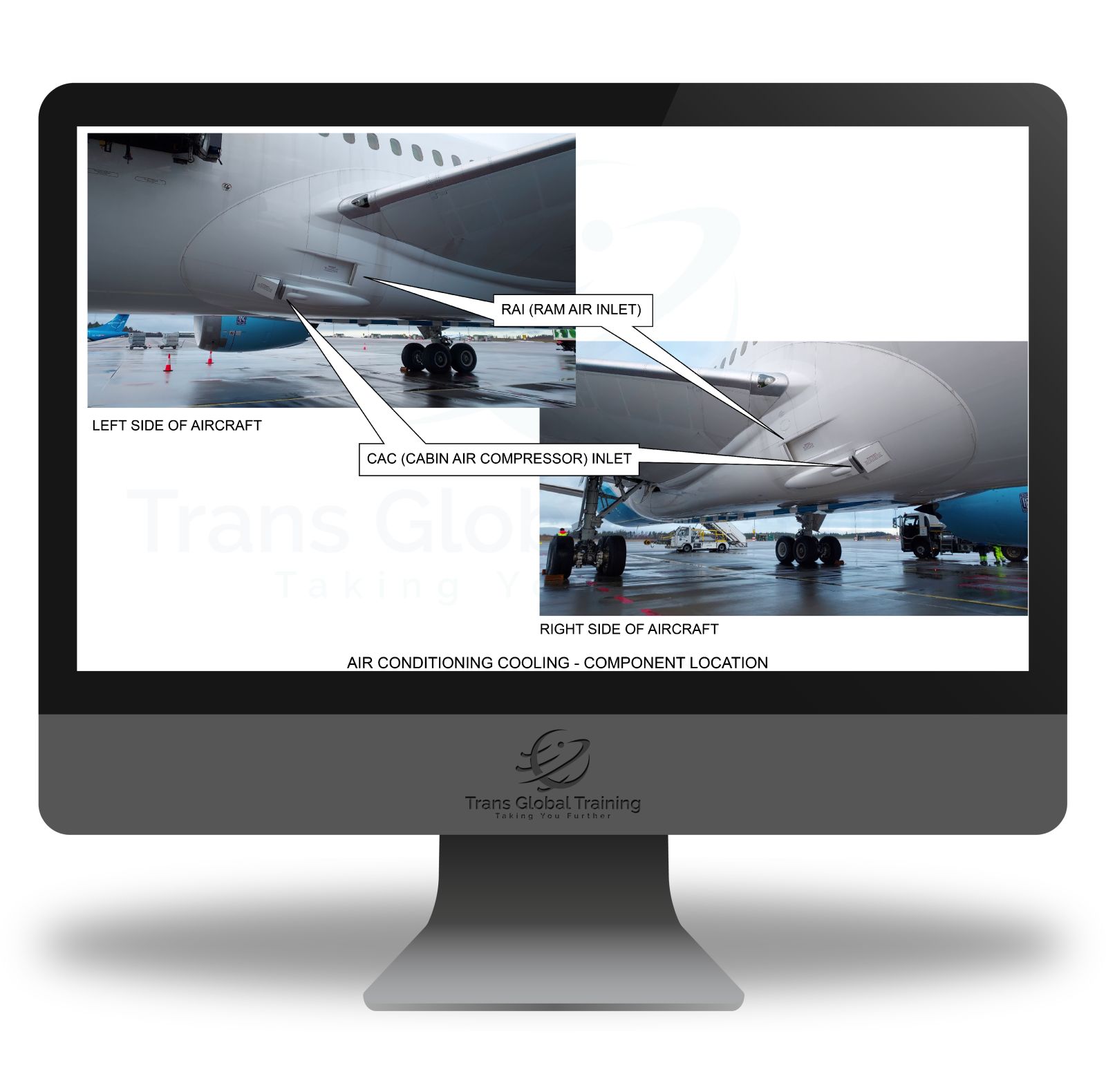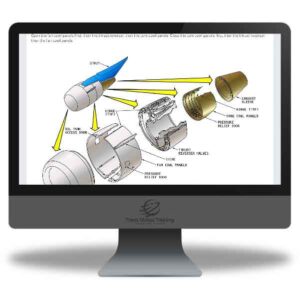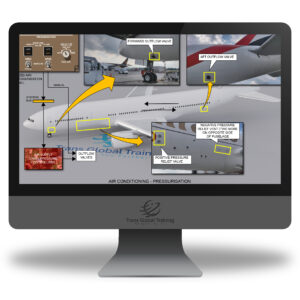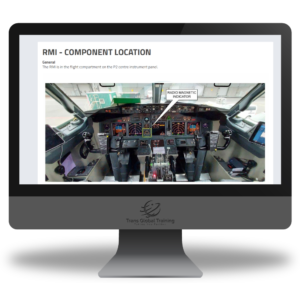
Shop
Boeing 787 GNex & RR Trent General Familiarisation
£375.00
Our Courses Scale Perfectly To Any Device
About our Online Self-Study Course
The Boeing 787 GNex & RR Trent General Familiarisation course has been designed to give you a complete technical overview of all aircraft systems. The course covers all mechanical and avionics systems, This self–study online Boeing 787 GNex & RR Trent General Familiarisation course will take approximately 40 hours of study. Students must pass the multi-choice question at the end of each ATA chapter before the next ATA chapter is unlocked. A completion certificate is issued on successful completion of the course.
Our Boeing 787 GNex & RR Trent General Familiarisation course is produced to a minimum of ATA 104 Level 1 and EASA Part 66 Level 1 knowledge levels and course completion time will be approximately 40 hours. This information is stated on the certificate.
You have 12 months from enrollment to begin the course and after starting, 6 months to complete the course. You have a further 90 days to review the course after completion.
Click on the DESCRIPTION below for course syllabus and more details. Please click here to view our sample course
When checking out, please ensure you use the student’s name. To enroll multiple students in the same course, please make separate transactions or contact us for team discounts
Description
BOEING 787 GNex & RR TRENT GENERAL FAMILIARIZATION COURSE
ABOUT
The Boeing 787 GNex & RR Trent General Familiarisation course meets ATA 104 Specification Level I: General Familiarisation; A brief overview of the airframe, systems and powerplant as outlined in the Systems Description Section of the Aircraft Maintenance Manual.
The course also complies with EASA’s knowledge LEVEL 1 definition as contained in Regulation EU No. 1321/2014, Part 66, Appendix III Basic Knowledge Requirements;
A familiarization with the principal elements of the subject, with the objective;
(a) The applicant should be familiar with the basic elements of the subject.
(b) The applicant should be able to give a simple description of the whole subject, using common words and examples.
(c) The applicant should be able to use typical terms
This self-study online Boeing 787 GNex & RR Trent General Familiarisation course will take approximately 40 hours of study. Students must pass a quiz at the end of each ATA chapter before the following ATA chapter is unlocked. A completion certificate is issued on successful completion of the course.
Course objectives: upon completion of the course, the student will be able to identify safety precautions related to the airframe, it’s systems and powerplant.
Identify maintenance practices important to the airframe, it’s systems and powerplant
Define the general layout of the aircraft’s major systems.
Define the general layout and characteristics of the powerplant.
Identify special tooling and test equipment used with the aircraft.
SYSTEM REQUIREMENTS
Our courses scale perfectly to PC, Laptop, tablet, android and iPhone. You must have an internet connection to use our courses.
STUDY TIME
Course completion time varies with the individual; however, we estimate approximately 40 hours will be required. You have 6 months to complete the course and can stop and restart at the same position with your progress saved. Once completed you will have a further 90 days to review the course.
SUPPORT
Should you require any assistance during your course, please contact us and we will assist you during normal working hours.
WHY USE OUR GENERAL FAMILIARIZATION COURSES?
Our online Boeing 787 GNex & RR Trent General Familiarisation course provides an excellent solution for training engineers or company support staff, giving the required in-depth aircraft type knowledge with the advantage of distance learning.
WHY BUY FROM US?
Our Boeing 787 GNex & RR Trent General Familiarisation course is designed and produced by EASA and UK CAA B1/B2 Engineers, Type instructors and Part 147 Training Managers. We ensure each course covers all relevant ATA chapters.
DETAILED COURSE SYLLABUS
DETAILED COURSE SYLLABUS
The Boeing 787 GNex & RR Trent General Familiarisation course begins with an aircraft type introduction, then covers each ATA chapter to approximately Part 66 Level 1;
B787 Introduction
B787 – Maintenance Data – Boeing Toolbox, B787 – Maintenance Data – Boeing Toolbox, Data Module Code, General Description 787-8, Aircraft Structure, General Description 787-9, Aircraft Operating Weights, Aircraft Dimensions 787-8, Aircraft Taxiing, Aircraft Towing, Aircraft Fuselage, Aircraft Jack Point Locations, Aircraft Major Zones, Panel Fasteners, Aircraft Levelling, Passenger And Cargo Compartment Doors, Ground Servicing Arrangement, Electronic Equipment Handling, Electronic Equipment Bays, Forward Ee Bay, Aft EE Bay, Cargo Compartment Equipment Racks, Cargo Compartment Equipment Racks, Bulk Cargo Compartment Equipment Rack, Flight Deck
ATA 21 – Air Conditioning
Air Conditioning Systems, Air Conditioning Distribution, Air Conditioning Distribution – Component Location, Air Conditioning Distribution – Operation, Main Air Distribution,
Cabin Air Supply Ground Connection, Recirculation System, Recirculation System – Component Location, Recirculation System – Operation, Lavatory/Galley Ventilation (LGV) System, Equipment Cooling System, Aft Equipment Cooling, Forward Electronic Equipment (Ee) Cooling System, Miscellaneous Equipment Cooling System, Equipment Cooling System – Component Location, Crew Rest Area Air Distribution System, Pressurisation, Pressurization Control System, Pressurization Control – Component Location, Cabin Pressure Control System (CPCS), Cabin Pressure Control System – Component Location, Cabin Pressure Control System – Component Location, Cabin Pressure Control System – Component Location, Cabin Pressure Control System – Maintenance Page, Heating, Heating – Passenger Compartment, Heating – Component Location, Crew Rest Area Heating System, Forward Cargo Compartment Heating System, Forward Cargo Compartment Heating System – Operation, Aft And Bulk Cargo Compartment Heating System, Aft And Bulk Cargo Compartment Heating System – Component Location, Aft And Bulk Cargo Compartment Heating System – Operation, Supplemental Heating System, Air Conditioning Cooling, A/C Cooling – Conditioned Air, Air Conditioning Cooling – Component Location, Air Conditioning Cooling – Component Location, A/C Cooling – Conditioned Air System – Operation, Pack Flow Control System – Cabin Air Compressor, Pack Flow Control System – Cabin Air Compressor – Operation, Pack Cooling And Pack Temperature Control System – Overheat Detection System, Integrated Cooling System, Integrated Cooling System – Component Location, Integrated Cooling System – Operation, Forward Cargo Air Conditioning, Forward Cargo Air Conditioning – Operation, Temperature Control, Zone Temperature Control System – Operation, Zone Trim System, Moisture/Air Contaminant Control, Humidification System, Crown Dehumidification System,
Ozone Control – Ozone Converter, Power Electronics Cooling System, Power Electronics Cooling System – Component Location
ATA 22 – Autoflight
Autoflight, Autopilot Flight Director System – Component Location, Autopilot Flight Director System – Component Location, Autopilot Flight Director System – Component Location, Autopilot Flight Director System – Component Location, AFDS – Altitude Hold – Operation, AFDS – Approach – Operation, AFDS – Approach – Operation, AFDS – Approach/Autoland – Operation, AFDS – Autoland Pitch – Operation, AFDS – Autoland Roll And Yaw – Operation, AFDS – Disengagement – Operation, AFDS – Engagement – Operation, AFDS – Flight Level Change – Operation, AFDS – Go-Around – Operation, AFDS – Heading/Track Hold – Operation, AFDS – Heading/Track Select – Operation, AFDS – Indications – Head-Up Display, AFDS – Indications – Hud – FMA, AFDS – Indications – Hud – Asa, AFDS – Indications – Hud – Fd, AFDS – Indications – Navigation Display, AFDS – Operation – Indications – Primary Flight Display, AFDS – Indications – PFD – Flight Mode Annunciator, AFDS – Indications – PFD – Autopilot Status Annunciation, AFDS – Indications – PFD – Flight Director, AFDS – Lateral Navigation (Lnav), AFDS – Mode Control Panel – Operation, , AFDS – Overview – Operation, , AFDS – Pitch, AFDS – Roll, AFDS – Takeoff, , AFDS – To/Ga, A/P Disconnect, And Heading Reference Switches, AFDS – Vertical Speed/Flight Path Angle, AFDS – Vnav, Thrust Management System, Thrust Management System – Control, , Thrust Management System – Flare And Retard, Thrust Management System – Flight Level Change, Thrust Management System – Go Around, Thrust Management System – Indications, Thrust Management System – Overview, , Thrust Management System – Speed, Thrust Management System – Takeoff, Thrust Management System – Vnav Climb, Thrust Management System – Vnav Cruise, Thrust Management System – Vnav Descent
ATA 23 – Communications Systems
High Frequency Communication System, HF System – Power Interface, HF System – Interfaces – Tuning Control Panels, HF System – System Interfaces, High Frequency Communication System – Component Location, High Frequency Communication System – Component Location, HF Communication System – TCP Operation – General, HF Communication System – TCP Operation – Radio Misc Page, HF Communication System – ACP Operation, HF Communication System – DCMF Operation, HF Communication System – Operation, Very High Frequency Communication System, VHF Communication System – Component Location – Flight Compartment, VHF Communication System – Component Location – Forward Ee Bay, VHF Communication System – Component Location – Aft Ee Bay, VHF Communication System – Component Location – Antennas, VHF Communication System – Operation, VHF System – Operation – ACP, VHF System – Operation – TCP, Satellite Communications (Satcom) System, Satellite Communications (Satcom) System – Component Location – Aft Ee Bay, Satellite Communications (Satcom) System – Component Location – HGA And DLNA, Satcom – Interface – Power, Satcom – Interface, Satcom System – Operation, Satcom – Operation – TCP, Satcom – Operation – ACP, Selective Calling (SELCAL) System, Emergency Locator Transmitter System, Emergency Locator Transmitter System – Component Location, Emergency Locator Transmitter System Operation, Data Communication Management Function, DCMF – Operation, Data Communication Management Function – Operation – Main Menu, Flight Interphone System, Flight Interphone System- Component Location – Flight Compartment, Flight Interphone System – Component Location, Service Interphone System, Service Interphone System – Component Location, Service Interphone System – Operation, Static Dischargers, Video Surveillance System (VSS)
ATA 24 – Electrical Power
Electrical Power, Current Return Network (CRN), Power Distribution System, 235 V AC Power Distribution, 115 V AC Power Distribution, 28 V DC Power Distribution, Generator Drive, Generator Drive System – Component Location, APU Starting, Common Motor Start Controller System, Common Motor Start Controller Control, AC Generation, Electrical Power Generation And Start System, EPGSS – Component Location, DC Generation, DC Power, Batteries, Battery Enclosure, Standby Power, Standby Power – Component Location, Electrical Brake Power Conversion System, External Power, External Power – Ground Handling Mode, External Power – Ground Service Mode, External Power – Operation, AC External Power – Component Location, AC External Power – Operation, 230VAC Power Distribution, Remote Power Distribution System, Electrical Power – Controls
ATA 25 – Equipment & Furnishings
Flight Compartment, Passenger Compartment Areas, Galley Systems, Lavatories, Overhead Flight Attendant Rest, Emergency Equipment, Emergency – Decompression Warning Horn, Emergency – Door-Mounted Escape Slide Pack, Emergency – Emergency Descent Device, Emergency – Evacuation
ATA 26 – Fire Protection
Fire Detection, Fire Detection System Components, APU Fire Detection System, Cargo Compartment Fire Detection, Engine Fire And Overheat Detection, Wheel Well Fire And Overheat Detection, Fire/Overheat Test Detection, Smoke Detector Test Detection, Fire Extinguishing, Fire Extinguishing – Component Location, Extinguishing – APU, Extinguishing – Cargo Compartments, Extinguishing – Engine, Extinguishing – APU Fire Extinguishing Bottle, Extinguishing – Cargo Compartment Fire Extinguishing, Engine Fire Extinguishing
ATA 27 – Flight Controls
Integrated Flight Controls System, Primary Flight Control Function (PFCF), Primary Flight Control Function – Component Location, Primary Flight Control Function – Component Location, Primary Flight Control Function – Component Location, Primary Flight Control Function – Component Location, PFCF – Flight Deck, PFCF – Maintenance Displays, High Lift Function, Roll Control, Yaw Control, Rudder Control System – Component Location, Rudder Control System – Component Location, Rudder Control System – Component Location, Rudder Control System Overview, Trailing Edge Flap Skew Detection System Overview, Spoiler and Speedbrake Control System Overview, Spoiler and Speedbrake Control System – Component Location, Spoiler And Speedbrake Control System Function Description
ATA 28 – Fuel Systems
Fuel, Fuel Storage, Fuel Vent System, Pressure Refuelling System – Component Location, Pressure Refuelling System, Pressure Refuelling System, Pressure Refuelling System – Refuel Control Panel, Engine Fuel Feed System, Engine Fuel Feed System, Engine Fuel System – Fuel Transfer, Engine Fuel System – Fuel Control Panel, Engine Fuel System – Fuel Management Maintenance Page, Engine Fuel System – Fuel Overview Display, APU Fuel Feed System, APU Fuel Feed System, Defueling, Defueling – Defuel/Transfer, Fuel Jettison System, Fuel Jettison System, Fuel Jettison System, Fuel Quantity Indicating System, FQIS – EICAS Display, Fuel Pressure Indicating System
ATA 29 – Hydraulic Power
Hydraulic Power – Controls And Indications, Hydraulic Power – Ground Tests, Hydraulic Power – Synoptic Display, Hydraulic System, Hydraulic System, Hydraulic System – Special Functions, Hydraulic Ground Servicing System, Hydraulic Ground Servicing System, Ground Servicing System, Ram Air Turbine System, Ram Air Turbine System, Hydraulic Indicating, Hydraulic Power – Component Location
ATA 30 – Ice and Rain Protection
Wing Ice Protection System, Wing Ice Protection System – Component Location, Wing Ice Protection System – Operation, Engine Anti-Ice (GNex Engine), Engine Anti-Ice – Component Location- GNex Engine, Engine Anti-Ice – Operation, Cabin Air Compressor Inlet Ice Protection, Cabin Air Compressor Inlet Ice Protection – Component Location, Cabin Air Compressor Inlet Ice Protection – Operation, Pitot-Static Anti-Ice System, Pitot-Static Anti-Ice System – Component Location, Windows, Windshields, And Doors, Window Heat System, Window Heat System – Component Location, Window Heat System – Operation, Windshield Washer System, Windshield Washer System – Operation, Water/Waste Heating, Water/Waste Heating – Component Location, Primary Ice Detection System, Primary Ice Detection System, Primary Ice Detection System, Primary Ice Detection System – Component Location, Primary Ice Detection System (PIDS) – Operation
ATA 31 – Indicating and Recording Systems
Common Core System (CCS), Common Core System (CCS), Common Core System (CCS), Common Computing Resource (CCR) Cabinets, Operation – P5 Overhead Panel Switches, Operation – CCR Cabinet Reset Switches, CCS/CDN Maintenence Page Menu, Primary Display System (Pos), Head-Down Display (HDD), Head-Up Display (Hud) Projectors And Combiners, Hud Declutter Switch, EFIS/DSP Control Panel, Multifunction Keypad, Cursor Control Device, PFD Switching, PFD Switching, Engine Indicating And Crew Alerting System (EICAS), Navigation Display, Control Display Unit,
Sys Switch – Status Page, Sys Switch – Synoptic Pages, Sys Switch – Synoptic Pages, System Menu – Maintenance Pages, Maintenance Pages – Central Maint, Maintenance Pages – CB, Caution And Warning System, Caution And Warning System, Stall Warning Function, Master Warning And Caution Lights, Takeoff Alert Inhibits
ATA 32 – Landing Gear
Landing Gear Doors, Landing Gear – Gear And Doors, Landing Gear – Maintenance Pages – Operation, Proximity Sensing System (PSS), Proximity Sensing System Function, Proximity Sensing System – Operational Test, Air/Ground System, Air/Ground System (AGS) – Operation, Main Landing Gear (MLG) Doors, Main Landing Gear (MLG) Details, Nose Landing Gear (NLG), Landing Gear Control System, Landing Gear Control System, Landing Gear Control System – Operational Test, Main Landing Gear Extension And Retraction System, Nose Landing Gear Extension And Retraction System, Landing Gear Alternate Extension And Door Release – Safety, Landing Gear Alternate Extension And Door Release – Actuation, Wheels And Brakes, Brake Actuation System, Wheels And Brake System Operation Description, Wheels And Brake System – Special Functions, Wheels And Brake System – System Test, Nose Wheel Steering (NWS), Nose Wheel Steering System – Operation, Landing Gear Position Indicating And Warning System, Landing Gear Position Indicating And Warning System, Tail Strike Protection System
ATA 33 – Lighting Systems
Lighting – General, Flight Deck Lighting, Flight Compartment Illumination – Operation, Passenger Compartment Illumination, Passenger Compartment Illumination – Overview, Passenger Compartment Illumination – Cabin Attendant Panel, Lavatory Lights and Signs, Lavatory Lights and Signs, Galley Lights, Galley Lights, Passenger Call Lights, Attendant and Crew Rest Lights, Attendant and Crew Rest Light, Service Lights, Service Lights, Cargo Compartment Lights, Cargo Compartment Lights, Wing Illumination Light System, Wing Illumination Light System, Landing, Runway Turnoff, and Taxi Lights, Double Power Supply and Nose Landing/Taxi Lights, Triple Power Supply, Landing/Turnoff Lights, and Non-Normal Conditions, Position Light System, Anti-Collision Lights, Logo Light System, Exterior Passenger Door Viewing Lighting, Exterior Passenger Door Viewing Lights, Emergency Lights, Emergency Lights Power, Emergency Lights, Emergency Lighting System
ATA 34 – Navigation Systems
Navigation Systems – Air Data Reference System, Pitot-Static System, Pitot-Static System – Component Location, Air Data System, Air Data System, Earth Reference System, Earth Reference System – Component Location, ERS – Display – Head-Up Display, ERS – Display – Primary Flight Display, Standby Magnetic Compass System, Integrated Standby Flight Display System, Integrated Navigation Radio System, INR System – ILS/GLS, INR System – Marker Beacon, INR System – VOR, Integrated Navigation Radio System, Integrated Navigation Radio System – Component Location, Low Range Radio Altimeter System – (LRRA), Low Range Radio Altimeter System – Component Location, Integrated Surveillance System, ISS – Air Traffic Control System
ATA 35 – Oxygen Systems
Crew Oxygen System, Crew Oxygen System – Component Location, Crew Oxygen System, Crew Oxygen System, Passenger Oxygen System, Passenger Oxygen System – Component Location, Portable Oxygen System
ATA 38 – Water/Waste System
Potable Water System, Potable Water System – Component Location, Potable Water System, Lavatory Water Heater, Water Quantity Indication – Water Service Panel Module – Power, Potable Water System Pressurization – Pressure Sensor, Potable Water System Pressurization – Water Pumps, Waste Water System, Waste Water System – Cabin Attendant Panel, Gray Water/Drain System – Galley Clog Removal Valve, Gray Water/Drain System – Lavatory Gray Water Interface Valve, Vacuum Waste System – Vacuum Blower – Power, Vacuum Waste System – Component Location, Vacuum Waste System – Vacuum Blower – System, Vacuum Waste System – Vacuum Waste System Service Panel, Waste Tank Quantity Indication System – Waste Tank Continuous Level Sensor, Galley Waste Disposal System – Galley Waste Disposal Unit
ATA 45 – Maintenance Systems
Central Maintenance Computing Function, CMCF – Component Location, CMCF – Component Location, CMCF – Component Location, CMCF Correlation, CMCF Correlation, CMCF Correlation, CMCF Correlation, CMCF Correlation, CMCF Correlation, CMCF Correlation, CMCF – Control And Display Devices, Airplane Condition Monitoring Function, Airplane Condition Monitoring Function, Onboard Data Load Function
ATA 46 – Information Systems
Core Network System, Operation – Data Networks, Crew Wireless Lan, Terminal Wireless Lan, Central Maintenance Computing Function
ATA 47 – Inert Gas System
Inert Gas System, Inert Gas System – Special Functions, Generation And Storage, Generation/Storage – Component Location, Nitrogen Generation System (NGS) Distribution System, NGS Controlling, NGS Indicating, NGS Indicating
ATA 49 – (Airborne) Auxiliary Power Unit
Airborne Auxiliary Power (APU), Auxiliary Power Unit (APU) – Operation, APU Power Plant, APU Power Plant – Component Location, APU Engine Overview, APU And Generator Lubrication System, APU And Generator Lubrication System – Component Location, APU Engine Fuel System, APU Engine Fuel System – Component Location, APU Ignition System, APU Ignition System – Component Location, APU Control System, APU Control System – Component Location, APU Indicating System, APU Indicating – Component Location, APU Exhaust System, APU Exhaust System – Component Location, APU Oil Indicating System, APU Oil Indicating System – Component Location
ATA 52 – Doors
Door Seals, Passenger Entry Door System, Passenger Entry Door System, Passenger Entry Door System: Function, Passenger Entry Door System Operation, Emergency Exit Door, Forward Cargo Door, Forward Cargo Door Mechanical, Aft Cargo Door, Aft Cargo Door Mechanical, Bulk Cargo Door, Cargo Doors – Operation, Service And Miscellaneous Doors, Service And Miscellaneous Doors – Equipment Doors, Interior Doors, Door Warning System, Door Warning System
Power Plant
Power Plant System, Power Plant – Bootstrap, Engine Cowling, Cowling – Component Location, Cowling – Power Door Opening System, Engine Mounts – Component Location, Engine, Air Inlet Section – Component Location, Compressor Section, Turbine Section, Turbine Section – Component Location, Accessory Drives, Accessory Drives – Component Location, Engine Fuel And Control, Fuel Distribution System, Fuel Distribution System – Component Location, Fuel Control System, Fuel Indicating System, Engine Ignition, Ignition Power Supply, Ignition – Component Location, Engine Air System, Booster Anti-Icing System, Booster Anti-Icing – Component Locations, Engine Cooling System, Engine Cooling – Component Location, Compressor Control System, Compressor Control – Component Location, Engine Controls, Power Control – Component Location, Engine Indicating, Power, Power – Component Location, Temperature Indication, Temperature Indication – Component Location, Analysers, Exhaust System, Thrust Reverser System – Component Location, Thrust Reverser Actuation And Control System, Thrust Reverser Proximity Sensors, Thrust Reverser Proximity Sensors – Component Location, Engine Oil, Engine Oil Storage, Engine Oil Distribution, Engine Oil Indicating System, Engine Starting System, Engine Starting Cranking System, Starting and Shutting Down the Engine
